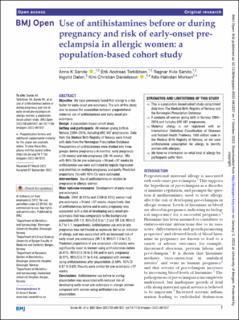| dc.contributor.author | Sande, Anne Kvie | |
| dc.contributor.author | Torkildsen, Erik Andreas | |
| dc.contributor.author | Sande, Ragnar | |
| dc.contributor.author | Dalen, Ingvild | |
| dc.contributor.author | Danielsson, Kim Christian | |
| dc.contributor.author | Morken, Nils-Halvdan | |
| dc.date.accessioned | 2023-01-09T14:58:39Z | |
| dc.date.available | 2023-01-09T14:58:39Z | |
| dc.date.created | 2022-10-21T04:14:30Z | |
| dc.date.issued | 2022 | |
| dc.identifier.issn | 2044-6055 | |
| dc.identifier.uri | https://hdl.handle.net/11250/3042070 | |
| dc.description.abstract | Objective: We have previously found that allergy is a risk factor for early-onset pre-eclampsia. The aim of this study was to assess the association between pregestational maternal use of antihistamines and early-onset pre-eclampsia.
Design: A population-based cohort study.
Setting and participants: All women giving birth in Norway 2004–2016, including 692 487 pregnancies. Data from the Medical Birth Registry of Norway were linked with data from the Norwegian Prescription Database. Prescriptions of antihistamines were divided into three groups: before pregnancy (<6 months), early pregnancy (<20 weeks) and late pregnancy (20–36 weeks). ORs with 95% CIs for pre-eclampsia <34 and <37 weeks by antihistamine use were estimated by logistic regression and stratified on multiple pregnancy and parity. Predicted proportions (%) with 95% CIs were estimated.
Interventions: Use of antihistamines in relation to pregnancy in allergic women.
Main outcome measures: Development of early-onset pre-eclampsia.
Results: 2997 (0.43%) and 5769 (0.83%) women had pre-eclampsia <34 and <37 weeks, respectively. Use of antihistamines before and in early pregnancy was associated with a risk of developing early-onset pre-eclampsia that was comparable to the background population (OR 1.0, 95% CI 0.8 to 1.2 and OR 0.9, 95% CI 0.7 to 1.1, respectively). Antihistamine use only in late pregnancy was not treated as exposure, but as an indicator of allergy, and was associated with an increased risk of early-onset pre-eclampsia (OR 1.8, 95% CI 1.5 to 2.2). Predicted proportions of pre-eclampsia <34 weeks were significantly lower in women using antihistamines before (0.41%, 95% CI 0.34 to 0.49) and in early pregnancy (0.37%, 95% CI 0.31 to 0.44), compared with women using antihistamines after placentation (0.69%, 95% CI 0.57 to 0.83). Results were similar for pre-eclampsia <37 weeks.
Conclusions: Antihistamine use before or during placentation was associated with reduced risk of developing early-onset pre-eclampsia in allergic women compared with women using antihistamines after placentation. | en_US |
| dc.language.iso | eng | en_US |
| dc.publisher | BMJ | en_US |
| dc.rights | Navngivelse-Ikkekommersiell 4.0 Internasjonal | * |
| dc.rights.uri | http://creativecommons.org/licenses/by-nc/4.0/deed.no | * |
| dc.title | Use of antihistamines before or during pregnancy and risk of early-onset pre-eclampsia in allergic women: a population-based cohort study | en_US |
| dc.type | Journal article | en_US |
| dc.type | Peer reviewed | en_US |
| dc.description.version | publishedVersion | en_US |
| dc.rights.holder | Copyright 2022 the authors | en_US |
| dc.source.articlenumber | e061837 | en_US |
| cristin.ispublished | true | |
| cristin.fulltext | original | |
| cristin.qualitycode | 1 | |
| dc.identifier.doi | 10.1136/bmjopen-2022-061837 | |
| dc.identifier.cristin | 2063449 | |
| dc.source.journal | BMJ Open | en_US |
| dc.identifier.citation | BMJ Open. 2022, 12 (10), e061837. | en_US |
| dc.source.volume | 12 | en_US |
| dc.source.issue | 10 | en_US |

